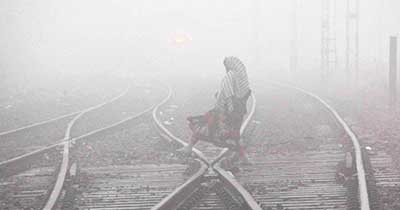Relevance: GS-1 & GS-3: Important Geophysical Phenomena
Key phrases: Disaster and Disaster Management
Why in news?
- India Meteorological Department (IMD) has predicted a cold wave in parts of Punjab, Haryana, Chandigarh, Gujarat, Rajasthan and Uttar Pradesh
Analysis:
What is a cold wave?
- Cold wave conditions occur during the winter months when the cold air mass from higher latitudes sweeps over the region. In the rear of well-marked moving low/pressure system in the westerly.
- Wind flow of mid-latitudes, which travel from west to east, winds from north-westerly/ southwesterly direction in northern/southern hemisphere prevail and bring cold air mass from higher latitudes.
- IMD follows separate criteria for plains and hilly regions.
- Plain: A cold wave is declared when the minimum temperature is equal to or less than 10 degree Celsius at a weather station in the plains. This temperature should be 4.5 degrees to 6.4 degrees below the normal temperature for that period.
- A cold wave may also be recorded at a station in the plains when the minimum temperature is less than or equal to 4 degree Celsius.
- Hilly areas: A cold wave is declared when the minimum temperature is less than or equal to 0 degree Celsius and the minimum temperature is 4.5 degrees to 6.4 degrees below the normal.
- The ‘normal’ temperature is calculated for every five days by taking the average temperature for these days over the past 30 years.
Definition of cold wave:
- The IMD defines a cold wave qualitatively as “a condition of air temperature which becomes fatal to the human body when exposed.”
- The IMD also has an ‘impact matrix’ for cold waves – when cold wave conditions persist in isolated areas for more than two days, the impact matrix indicates that the cold is tolerable but “a mild health concern for vulnerable people (infants, pregnant women, elderly, people with chronic diseases etc.”
- It suggests avoiding prolonged exposure to the cold, and covering the head, neck, hands and toes as “majority of heat loss occurs through these body parts.”
Conditions favourable for cold wave
- The conditions favourable for cold wave are:
- Inflow of cold air mass from higher latitudes over the region of well-marked low pressure system
- Foggy weather during the day which inhibits day warming of the region
- Strong radiation cooling during the night under clear sky conditions
Cold Wave and Thermal Stress
- By prolonged exposure to cold wave conditions, abnormally low body
temperature may occur as the body loses heat faster than it can produce by
muscle contractions, metabolism and shivering. Cold wave related illnesses
are:
- Frostnip, which cause numbness or may temporarily cause blue-white skin colour.
- Chill blains
- Frostbite
- Hypothemia - an emergency condition which needs immediate medical attention.
La-Nina and cold wave
- For the northern parts of India, it is likely that the La Nina weather phenomenon may result in extreme cold from December 2021 to February 2022.
- The warm phase of the east and the central Pacific Ocean, periodically seen once in two-seven years, is termed as El Nino and the reverse process of cooling in the same area, is labelled as La Nina.
- This phenomenon impacts the flow of trade winds, prevalent on either side of the equator.
- La Nina is expected to carry on with an 85 percent chance in December 2021-February 2022.
- It will transport cold air over the Indian subcontinent from Siberia and South China, thus leading to cold wave like conditions.
The 2017-cold wave in India
- Northern India was devastated by a cold wave during the month of January 2017.
- The lowest temperature in Gulmarg due to the cold wave was recorded at −12.4 °C.
- Five people including an army officer, died in an avalanche in Kashmir. Four members of a family were killed in avalanches in the Ganderbal and Bandipora districts of Kashmir.
Conclusion
- The frequency and severity of occurrence of cold waves and their severity is dependent on factors like the geographical location and the c1imatic conditions of the region.
- Most vulnerable are those who are in the susceptible age groups like the very young and the old or the infirm.
- Weaker sections of the society who cannot afford to ensure protection against the extremes of weather are also among the, easy targets of the extreme weather conditions.
- The best way to prevent illnesses is, however, to avoid prolonged exposure to outdoor environment during cold wave conditions.
Source: The Hindu BL









